What is Mobile Marketing?
Mobile marketing refers to the practice of interacting with mobile users throughout their entire lifecycle. This is achieved by consistently engaging with app users throughout the acquisition, activation, and retention stages of the user’s funnel. Mobile marketers can take advantage of multi-channel digital marketing strategies to target, reach, engage, and convert users on smartphones, tablets, and other mobile devices.
50%
Mobile marketing will account for more than 50% of global ad spend in 2022, overtaking desktop and traditional web outlets
$170B
Consumers spent an all-time high of $170B worldwide across the major app stores in 2021, a 30% increase over 2020
3 Stages of The Mobile User Lifecycle

1. Acquisition
During the user acquisition stage, mobile marketers will need to drive installs and engage new users by encouraging interaction within their mobile app. Interaction, and ultimately conversion, can be achieved by employing a variety of distribution methods including social media, search, display, in-app promotions, app store optimization (ASO) campaigns, and more.
Perform[cb] worked with Acorns to develop a new user acquisition strategy, which resulted in a 52x increase in installs. Contact Perform[cb]’s team of mobile marketing experts to increase your new user acquisition now.

2. Activation
Driving users to install your app is just the tip of the iceberg when it comes to the mobile app lifecycle. After three days of downloading, 77% of users are likely to abandon a new app. Users tend to install and test multiple apps at once across the same category, so establishing differentiation in the activation stage is important. Strategies such as push notifications, in-app messages, and conversion incentives are just a few ways app marketers can retain new users. With an effective messaging strategy, mobile marketers can remind and demonstrate to users how their app adds value to their lives.

3. Retention
Having a strategic retention strategy is how mobile marketers can keep users engaged, active, and profitable over the long term. Users should be nurtured through personalized user experiences, relevant discounts or coupons, and engaging content. Mobile marketers who proactively engaged with users saw their 90-day retention results increase to 48% – double the industry average. Oftentimes marketers put all their focus on the acquisition of new users rather than retention of loyal users, which can result in shortened customer lifetime value (CLV) and stunted ROI.
The Average Consumer Spends More Than 5 Hours Per Day On Their Smartphone
Are you taking advantage? Talk to a mobile user acquisition expert today.

Mobile Marketing Campaign Types
Display
- Display advertising can take a variety of forms, including banners ads, retargeted ads, native ads, social media ads, and geofencing. Depending on your KPIs, mobile display advertising offers many options for campaign targeting. When running mobile display ads, marketers have the ability to enforce a full-funnel approach to reach users on the go across multiple channels. Learn how Perform[cb] increased new users by 233% in one month for a popular banking app after running native display campaigns.


Social
- If your mobile marketing goals are to increase brand awareness, acquire new users, drive sales, or all of the above, then you need to invest in a strategic social media campaign. Does your ideal user spend most of their time on social media? Do they make purchases through an app or a mobile website? It’s important to invest in the social channels where your ideal audience is searching for your app, product, or service. As a result of the boom in e-commerce and increased social media consumption since 2020, social commerce spending has risen by 35.8% to $36.62 billion over the past year.
In-App Advertising
- So you’ve acquired new users, but how can you make sure you retain them? In-app advertising is currently the fastest growing form of mobile advertising on the market, performing 11x better than your typical banner ad. Mobile marketers must tailor the relevancy of their in-app ads to avoid creating a disturbance for the user. In-app advertising can take many forms, including in-app banners ads, rewarded video ads, and interstitial ads. Rewarded video ads are an effective way to drive high-quality conversions, as users are encouraged to engage with the ad in exchange for an in-app reward. As a result, this format has some of the highest conversion rates, and it can even help improve brand sentiment.


App Store Optimization (ASO)
- App store optimizations (ASO) should be routinely integrated into every mobile marketer’s campaign. Have you run A/B tests to learn what keywords your target audience is searching for? Are you optimizing your App Store listing with a keyword-rich title and description? Are you encouraging users to leave reviews and ratings to make your app more appealing? Just a few advantages of ASO include improving your app’s ranking, scaling consumer reach, driving traffic to your app, and increasing installs.
Learn how Perform[cb] helped a well-known gaming app rank #1 in the app store after running a keyword campaign.
Search
- App discovery doesn’t just happen in the app store. Many users become aware of new apps through a search engine. This is especially prevalent for local apps, as well as dating, tech, and travel categories. 92% of people who made a Google search on mobile ended up making a purchase or install related to their search. Marketers can improve their mobile search ads in a multitude of ways: use messaging that speaks to the target user, adapt all CTAs for mobile users, offer mobile-specific ad extensions, and make sure ads lead the user to an optimized landing page.nd it can even help improve brand sentiment.


Push Advertising
- App store optimizations (ASO) should be routinelyPush advertising has the ability to be highly customizable and personalized to the user, making it both cost-effective and known to drive a high click-through rate (CTR). 70% of users consider push notifications to be useful and 34% of users prefer to receive promotions this way. The most popular types of push advertising include in-app push notifications, mobile web push notifications, and smartwatch push notifications.
Interested in growing your user base to increase signups or registrations? Learn how expanding into push advertising with Perform[cb] led a leading entertainment marketer to achieve a 7% install-to-free trial conversion rate.
Mobile App Retargeting
- Mobile app retargeting ads are meant to target a pool of users who have previously engaged with a brand via mobile web, an app store listing, or in-app ads. The length of time a user stays in the cookie pool will depend on the marketer’s overall KPIs, and typically ranges from seven to 30 days. Mobile retargeting ads are more cost-effective and have been known to drive more lower-funnel conversions – the best of both worlds. There is a 62% lower cost for mobile app marketers to generate a lead when running retargeting campaigns, and many brands have seen a 50-60% increase in conversion rates when utilizing retargeting.

Pricing Models for Mobile
Marketing Campaigns
As a mobile marketer, why put your ad dollars towards impressions or clicks when you can run on a performance model and only pay for genuine conversions? Common pricing models for app marketers include Cost Per Install (CPI) and Cost Per Engagement (CPE). Learn more about which pricing model is right for your acquisition goals.


Cost per Install (CPI)
The cost per install (CPI) pricing model is one of the most widely used for mobile user acquisition campaigns. CPI is perfect for marketers looking to focus on driving installs and acquiring new active users. Learn how Perform[cb] executed a strategic CPI campaign to drive a 75% increase in new user acquisition month-over-month for a leading car insurance app.
By dividing the total amount spent on advertising by the total number of new mobile app installs, marketers can determine the cost of acquiring a new user over the course of their CPI campaign. Improve your conversion rates and keep a low CPI with Perform[cb]’s CPI Manager.
Cost Per Engagement (CPE)
The cost per engagement (CPE) pricing model drives users to interact and engage with a mobile marketer’s app. CPE is most commonly used to increase post-install engagement, including registrations or in-app purchases. CPE campaigns have the ability to be highly targeted, which can increase the overall quality of converting users.

What is a Mobile Marketing Network?
Mobile marketing networks, also known as mobile ad networks, work with marketers to construct, execute, optimize, and report on their mobile marketing campaigns. Often partnered with third-party publishers or affiliates, these networks serve as a middle point to connect marketers’ offers (promotions) with affiliate partners who will drive traffic to a marketer’s offer. Learn more about how to choose the best mobile marketing network for your user acquisition needs.


What is a Mobile Measurement Partner (MMP)?
- A mobile measurement partner (MMP) is a company that offers tracking services for mobile apps to help measure campaign performance and effectiveness across marketing channels, sources, and networks. Perform[cb] is a mobile marketing network that offers user acquisition services on a pay-for-results model, and is integrated with the industry’s leading MMPs including Adjust, AppsFlyer, Branch, Kochava, and Singular. Contact our team of mobile marketing experts today to optimize your user acquisition strategy.
Mobile Marketing Compliance
Mobile marketers must prioritize marketing compliance and data privacy. Marketing compliance not only saves apps from paying financially, but it also drives invaluable user trust. Tactics such as regular campaign monitoring, a cost-per-acquisition model, and employing a wide range of partners can better a mobile marketer’s chances of detecting and protecting against fraudulent activity.


Preventing Ad Fraud in Mobile Marketing
- Ad fraud within mobile marketing leads to wasted time, loss of ad spend, and inconclusive data. Mobile marketers must implement marketing compliance practices early in the planning process to avoid becoming a victim of ad fraud. There are many different types of mobile fraud, including fake in-app engagement, click spam, false installs, bad bots, and more. Learn more about how you can proactively shield your app campaigns from mobile ad fraud.
Mobile Expertise





















